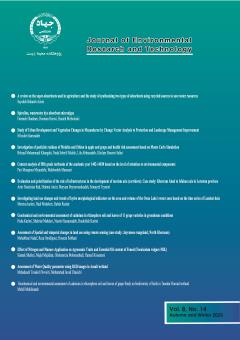Geochemical and environmental assessment of cadmium in rhizosphere soil and leaves of 11 grape varieties in greenhouse conditions
Subject Areas : خاکشناسی
Hoda Karimi
1
![]() ,
shahryar Mahdavi
2
*
,
shahryar Mahdavi
2
*
![]() ,
Nasrin Hasanzadeh
3
,
Nasrin Hasanzadeh
3
![]() ,
Rouhollah Karimi
4
,
Rouhollah Karimi
4
![]()
1 - PhD Student, Environmental Science Department, Research Institute for Grape and Raisin (RIGR), Malayer University, Malayer, Iran
2 - Associate Professor, Department of Soil Science, Faculty of Agriculture, Malayer University, Malayer, Iran
3 - Assistant professor, Department of Environment, Faculty of Environment and Natural Resources, Malayer University, Malayer, Iran
4 - Associate Professor, Department of Horticultural and Landscape Engineering, Faculty of Agriculture, Malayer University, Malayer, Iran
Keywords: Soil pollution, Geochemical indices, Cadmium, Grape varieties,
Abstract :
Cadmium is a toxic metal that has significantly increased its entry into the soil and food chain with the rise of environmental pollution. In this study, 11 grapevine cultivars (Vitis vinifera L.) were exposed to three levels of cadmium (0, 50, and 100 milligrams per kilogram) in a factorial experimental design based on a completely randomized design in the research greenhouse of Malayer University. After applying the different cadmium treatments over a period of approximately 4 months, leaf and rhizosphere soil samples of different grapevine cultivars were collected, and the concentrations of cadmium and zinc were measured using an atomic absorption spectrometer. Significant differences were observed among grapevine cultivars in terms of cadmium and zinc content in leaves and rhizosphere soil. The cultivar "Bidaneh Sefid" had the lowest cadmium content in leaves, while the highest cadmium content in rhizosphere soil was observed in the cultivar "Rish Baba." Moreover, the cultivar "Turkmen 4" had the highest zinc content in leaves, and the cultivar "Rish Baba" had the highest zinc content in rhizosphere soil. Geochemical indices including Igeo, Ipoll, CF, and BAC were evaluated in the surface soil compared to the standard shell and earthworm. Based on the results of this study, in the examination of soil indices in different grapevine cultivars and the impact of different cultivars, according to the Ipoll and Igeo (Müller) indices in the shell, in non-stressed soil without cadmium, it was considered slightly contaminated, and according to the standard shell in the earthworm, it was considered quantitatively contaminated. According to the Igeo index in the shell, in soil under 50 milligrams per kilogram of cadmium stress, it was considered slightly contaminated, and according to the Ipoll index, it was considered slightly to moderately contaminated, and according to the standard shell in the earthworm, it was considered heavily contaminated. According to the Igeo and Ipoll indices in the shell, the results of soil under 100 milligrams per kilogram of cadmium stress, were considered heavily contaminated, and according to the standard shell in the earthworm, it was considered severely contaminated. The results of these indices indicated that zinc was in the non-contaminated category.
Abrahim, G. M. S. and Parker, R. J. 2008. Assessment of heavy metal enrichment factors and the degree ofcontamination in marine sediments from Tamaki Estuary, Auckland, New Zealand, Environ Monit Assess, 136:227–238
Alloway, B. J. (2013). Sources of heavy metals and metalloids in soils. Heavy metals in soils: trace metals and metalloids in soils and their bioavailability, 11-50
. Barbour, MT., Gerritsen, J., Snyder, BD., Stribling, JB, 1999. Rapid bioassessment protocols for use in sreams and river: Pryphyton, Benthic Macroinvertebrates and fish. 2nd edition, Vol. pp. 841-B-99-002. USEPA, Washington D.C. 408p
. Bermudez, G.M., Jasan, R., Plá, R., and Pignata, M.L. 2012. Heavy metals and trace elements in atmospheric fall-out: their relationship with topsoil and wheat element composition. Journal of Hazardous Materials, 213: 447-456
. Bhuiyan, M. A. H., L. Parvez, M. A. Islam, S. B. Dampare and S. Suzukia. 2010. Heavy metal pollution of coal mine-affected agricultural soils in the northern part of Bangladesh. J. Hazard. Mater. 173: 384-392
.

